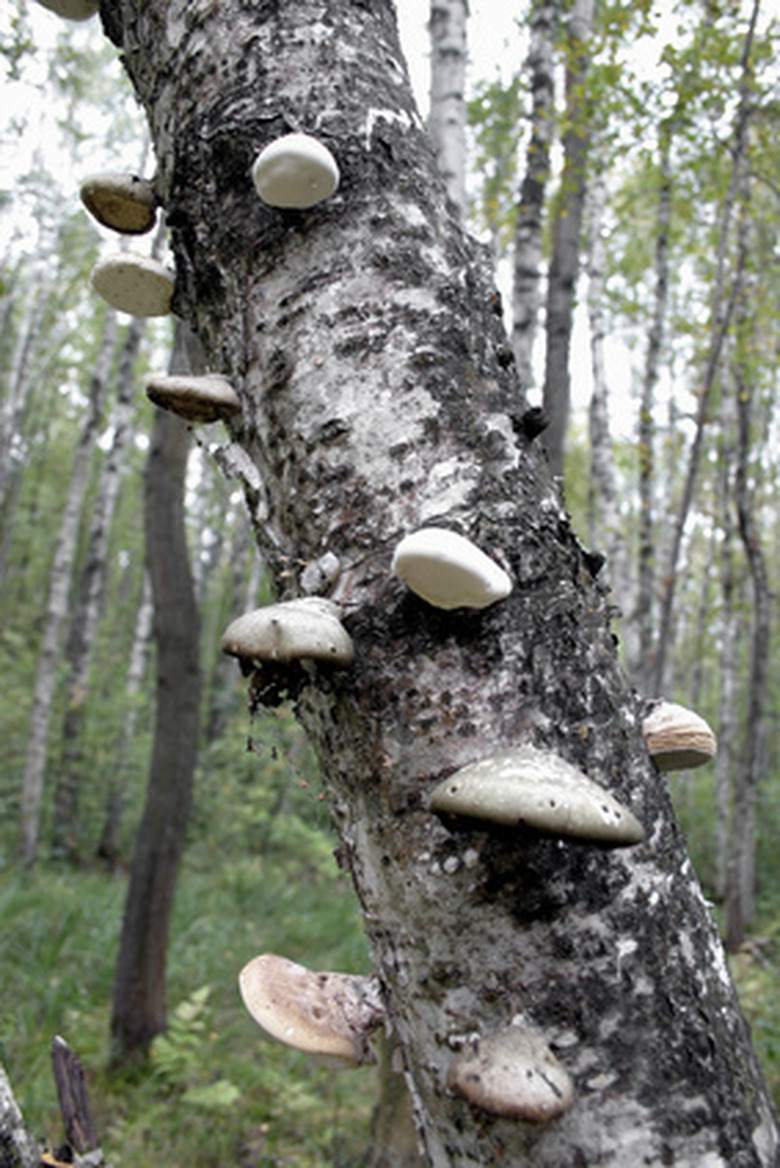Mushrooms That Grow On Birch Trees
Mushrooms that grow on birch trees are caused by fungi that prefer the birch tree as a host. The presence of mushrooms on birch is a red flag that your tree is under distress as mushrooms are symptoms of a fungal infection.
Fungal infections are dangerous for the health of trees, causing wood decay and possibly death. The best method of protecting your birch tree is through proper maintenance; vigorous trees often resist fungal disease. Fungicides are not recommended.
Oyster Mushroom
Oyster mushrooms (Pleurotus ostreatus) grow on birch trees. The mushrooms look like groups of shelves, have smooth uppers with gilled stalks, and measure 2 to 8 inches in width, according to the University of California IPM Online. Mushrooms appear in a variety of colors including white, cream, gray, brown, and lilac. This type of fungus causes wood decay; in addition to the presence of mushrooms on your birch tree, you may notice white rot with a flaking texture.
- Mushrooms that grow on birch trees are caused by fungi that prefer the birch tree as a host.
- This type of fungus causes wood decay; in addition to the presence of mushrooms on your birch tree, you may notice white rot with a flaking texture.
The decay caused by oyster mushroom fungi may remain in a centralized area, or may expand, stretching 10 feet above and below the mushrooms. The fungus associated with oyster mushrooms infects birch trees by entering open wounds. Since weakened trees are susceptible, keep your birch tree healthy to prevent infection.
Birch Polypore
Birch polypore (Piptoporus betulinus) is a mushroom that grows on birch trees, appearing alone or in groups. This type of fungus is parasitic; birch polypore feeds on birch trees, stealing their nutrients and causing diminished health and decomposition that leads to breakage, according to Messiah College.
Mushrooms are capped, white to gray-brown in color with dark striations, and measure approximately 1 to 10 inches in width. As with all fungal infections, maintain the vigor of your birch tree to prevent infection.
- The decay caused by oyster mushroom fungi may remain in a centralized area, or may expand, stretching 10 feet above and below the mushrooms.
Armillaria Root Rot
Armillaria root rot (Armillaria mellea), also referred to as shoestring rot, causes mushrooms that grow on birch trees. Trees that have been wounded or damaged by problems like drought, pest infestation, pollution, or physical injury, are the most likely to suffer from armillaria root root, according to the University of Illinois Extension.
This disease causes the death of feeder roots, making it difficult for the tree to gain nutrients, resulting in overall decline or death. Along with other symptoms such as yellowing of leaves and leaf drop, armillaria root rot fungus causes odorous, white- to cream-colored, fan-like mushroom growths (measuring 1 to 6 inches in width) on the trunk of the birch tree.
Low-lying wood decay will cause visible, vertical cracks. Since armillaria infects soil, it is important to replace infected soil with healthy soil, and to remove and destroy all diseased material, including severely diseased birch trees.
The University of Illinois Extension suggests "carefully removing the soil to expose the root collar and buttress roots to aeration and drying from mid-spring to late autumn" for trees with only minor infection for growth of healthy tissue.
- Armillaria root rot (Armillaria mellea), also referred to as shoestring rot, causes mushrooms that grow on birch trees.
- Since armillaria infects soil, it is important to replace infected soil with healthy soil, and to remove and destroy all diseased material, including severely diseased birch trees.
